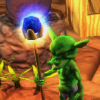first let me say I'm a programmer, so please be kind!
OK I'm leaning blender ( just for quick test stuff in my software ), I've learnt how to make a model, and howto texture map. However I've found when I make a complex model whatever kind of uv unwrap I try, whatever type of seam marking I try the map is all over. I can unwrap a simple shape, but a more complex on has it's faces all over the unwrap. By this I mean two polygons are togeter on a model, say the left and right of a charatcter face, however on the unwraped map they are on different sides of the texture. I've checked out multiple tutorials ( which are fine if you'er unwraping a cube ) but none seem to go into advanced stuff.
I may well be missing something but cannot be sure.
Can anyone offer advice in unwrapping complex shapes? Thanks in advance






